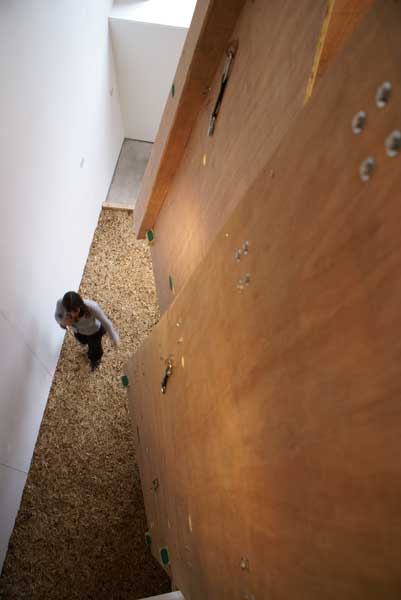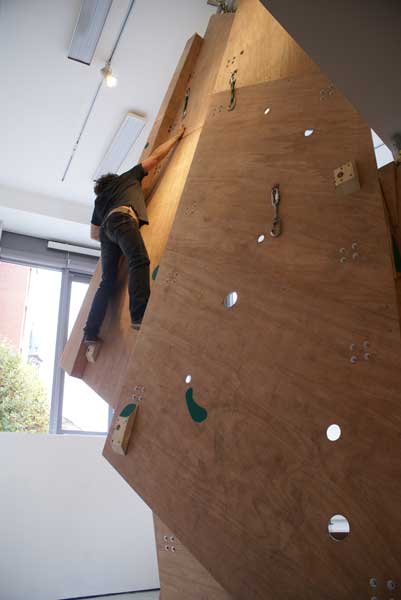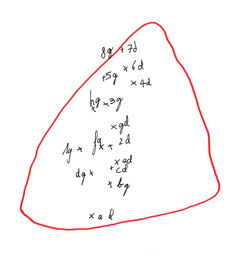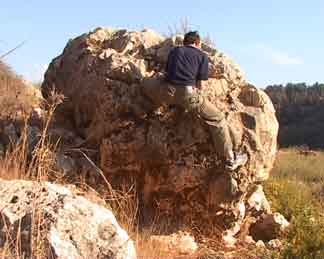



Radical Architecture - essay by Fergal Gaynor.
Various Routes across the Art of Dan Shipsides
Dan Shipsides ends the account of his art practice in Circa 111, ‘Performance on an Edge', by wondering whether “it is art? Is it even performance art?” It is a brave positioning of his work, and a conscious orientation toward contemporary practice in general. It is interesting that ‘performance art' should somehow be regarded as a kind of questionable extension of ‘art': the logic of the question suggests that something nameable as ‘performance art' might somehow not be ‘art'. There is an element here also of Shipsides' suspicion of ‘performance', i.e. theatricality, a feedback loop between audience reaction and self-awareness in presenting a work, that appears earlier in the article. ‘Art' with a capital ‘A', that which is recognizable as being art, and ‘performance art', less immediately recognizable as ‘art' but equally prone to a recognizable aesthetics, are traps of public presentation. It is hard not to become self-conscious, to try to be ‘successful', that is, gear the work towards the audience's response, bring to the fore those aspects which palpably communicate. The same suspicion seems to extend for Shipsides out to ‘scenes' and ‘clubs', groupings according to certain sets of acknowledged values, referring at the start of the same article to ‘predictable and consensual audiences'. Art that belongs to a scene is art geared towards the performance of certain recognised aesthetic values. Shipsides is concerned to maintain a distance from such recognitions: instead, he evokes a spirit of objective inquiry (‘part anthropology and part cultural engineering', as he puts it), or explores the possibilities of non-art.
*
Contemporary art worthy of attention contains an inquiry into or exposure of the conditions of its operation. It places these conditions in question. Therefore it is neither ‘art' nor ‘not art' that is of concern for contemporary practice, but the zone where the two interrogate each other: the place of the double of art outside of the artistic, the place of the resolutely resistant to artistic formal understanding (which is quite different to ignorance of formal understanding) within the economy of the artistic.
*
Rock-climbing is very like art: when the full range of the practice is examined it turns out to be something like art's twin. As Shipsides puts it: “ climbing routes could be considered as artworks: they are created; ‘authored'; named and dated; consumed; generate cultural currency (come to represent breakthroughs, test pieces, radical departures, re-articulations); assessed and reviewed (3-star ratings); and graded (according to technical difficulty and exposure)”. At times it even mimics the kind of art that Shipsides himself strives to make. On his website, referring to his work on the Rochers á Fontainebleau , he mentions that a “bouldering climbing route is, interestingly, referred to as a ‘problem'", thus aligning it with the impersonal forms of inquiry to which he also aligns his art. In common with the avant-garde it can also have a kind of socially progressive, utopian quality. Its development is marked by an extension of leisure-time once only enjoyed by the gentlemanly class out to the working class, and by a spirit of revolt against the tameness and safety of regulated urban life. A famous image of Steve Bancroft from the cover of a 1977 climbing book Recent Developments encapsulates this: he is young, working-class and has the unruly long hair of a seventies rebel. And he is hanging dangerously in the void, free, at ease physically, but with a facial intensity that suggests he is confronting something genuinely challenging with an edgy energy. It is an image of a counter-cultural hero: Che Guevara without the politics.
*
But this mirroring of art remains without focus if it doesn't have an intra-artistic complement – it is necessarily a double. In Shipsides' work climbing appears in the gallery in an almost fragmented way: various formal economies are employed, without any anxiety as to aesthetic contiguity. Here is a sculptural object, here a text, here a drawing, a video, some photographs. Each individual piece may be drawn into the discourse of contemporary art, but none is complete in itself, and the collection of pieces refuses to be subsumed within a single paradigm. Just as art draws a certain formality from climbing, climbing inscribes various routes across contemporary art.
*
 Gecko Roof
Gecko Roof
An installation like Shipsides' Gecko roof can be described as a post-minimalist object. Like the work of Robert Morris or Sol Le Witt it exists both as a sculptural form and an organisation of the formal space of the gallery – an aestheticisation of the viewer's physical environment. It also realises a radical possibility of this art in the wake of Greenbergian modernism. In taking further the logic of a pure art proposed by Greenberg – flat, color-field painting aspiring to the status of painting as painting – by breaking the pristine boundaries of the artwork and instead working with the gallery's formal space itself, minimalism introduced within the artwork the contingency of the occupants of that space, and the failure of ‘pure art' to remove all trace of referentiality, content or utility. Art passed through the eye of a formalist needle and came out the other side recontaminated with the chaos of the non-artistic. Thus despite Gecko roof's sufficiency as a graceful, sculptural organisation of space, it is also a working model of a dangerous climb in Sidney Harbour . To stress the point Shipsides has climbers attempt the replicated route in the gallery.
*
Rochers á Fontainebleau - Duel - Drawing 
There are also video and photographic documentations, but of what? A performance, or simply a climb? The drawings from the Rochers á Fontainebleau exhibition also occupy a space between the formal inscription of movement in two-dimensional space, the instructions for a climbing-route, and a document of the original authorship of that route: suggesting that the method reflects the original climber's personal style as surely as would their handwriting.
*
Gede is a ‘climbing poem'. Like the poems Vito Acconci wrote immediately prior to enacting his negotiations of social space in the physical space of a street with Following Piece in 1969, it works as a phenomenological exercise, opening up spaces of significance and moving between them, impersonally and without lyrical resonance. The movement is reflected in the pagination of the poem itself, which ‘climbs' upwards on the page, reversing the usual direction of text. On the other hand, it may be read as a set of instructions for the climb to which the piece refers: like Acconci it passes into the negotiation of physical space, albeit without introducing performance, maintaining its split, doubled character.
*
 Green Line Sisyphus
Green Line Sisyphus
There is a formal integrity to all this. But certain questions beg to be asked which threaten to reintroduce the terms of theatricality: self-consciousness, performance, the staging of subjectivity . . . Would any technically sophisticated practice, sport or craft, have fulfilled this role? Is not the artist's personal fascination with climbing an unavoidable element of all this, in other words, can the subjective experience of climbing be removed by the spirit of objective inquiry? At times it creeps in. The poem Clocks contains the interjection ‘squeeze fucker', suddenly instilling a sense of the intense sensations felt by the climber, clinging by his fingertips high up on a rock-face. This move is further explored in The Fear , a poem in which the persona of the climber as countercultural figure is brought to the fore, and the art becomes a little submerged by the coolness of the sport. It must be admitted that climbing belongs at present to the category of ‘extreme sports', which is to say that despite the skill, concentration and technical knowledge required, it cannot be entirely disassociated from matters of adrenaline, stimulation, risk and a sense of living on the edge. When this is considered, it is remarkable how seldom evocations of excitement and intense experience find their way into Shipsides' work. More typical is the tenor of Shipsides' description of his 20 minute DVD Green Line Sisyphus piece, in which the artist is seen repeatedly and seemingly endlessly climbing clockwise around a boulder situated on the ‘Green Line' between Palestinian and Israeli territories in the West Bank: “it's a nice traverse, pointless and unspectacular”. Though Camus' existentialist hero is evoked, the DVD remains uninterested in the dramatisation of the artist's gesture. More telling again, perhaps, is how the countercultural figure is generally kept at an ‘anthropological' distance, this distance often being achieved by the presentation of a representative climber, like Jo Brown, a pioneer of the sport in the forties and fifties, in their historical context.
*
This sense of historical context is enforced by the introduction of past artists into Shipsides' exhibitions. For Fontainebleau it was the Barbizon painters; for Manchester's Radical Architecture a number of representations of the Peak District will be included, among them a drawing by Ruskin. In this way the fascination of the artist (the lens which produces the doubling reflections of art and climbing) is woven into an impersonal narrative of engagement with the landscape. Art and climbing both perceptually explore the natural landscape: in fact, that landscape itself only comes into focus, is constructed as a significant affair, by such explorations. We know a landscape through its cultural representations: one generation sees beauty in landscape that promises crops and well-fed animals; another is drawn to wildernesses, to the untamed and humbling. Through these historical configurations runs a social narrative: the Jacobite rebellion becomes associated with the wildness of the Scottish Highlands; Walter Scott binds these associations together and the Highlands become an image of a lost, romantic pre-modern civilisation. “A hydroelectric plant is set into the current of the Rhine,” as Heidegger recounts in the ‘Question Concerning Technology', before going on to wonder whether the Rhine “is still a river in the landscape”, as common sense dictates. “Perhaps. But how? In no other way than as an object on call for inspection by a tour group ordered there by the vacation industry,” he concludes. The event of the establishment of the hydroelectric station in the river has changed the nature of the river itself, since whatever ‘nature' the river may have is bound up with its existence in the human, sign-giving world. Similarly, both climbing and art are ways in which such ‘nature' is determined.
*
. . . the visible scene
Would enter unawares into his mind
With all its solemn imagery, its rocks,
Its woods, and that uncertain heaven . . .
(‘There was a Boy')
Although the ‘nature' of a landscape may be understood as an ongoing historical project, and consequently Shipsides' art as ‘part anthropology part cultural engineering', it remains difficult in the wild landscapes of England not to be influenced by that Wordsworthian ‘nature' that was given shape chiefly in the Lyrical Ballads (from which the extract above comes) and the Prelude . Wordsworth is the locus classicus of the encounter of modern sensibility and wild landscape, especially the English landscape. In an inverted way a certain Wordsworthian influence may be perceived at work in Shipsides' art, and also in other contemporary approaches to landscape. It may be measured in the stringency with which a romantic sensibility is kept at bay: it is difficult, after all, for a sensitive individual in the face of the grandeur of the Lake District or the Peaks not to feel some of the ‘transports' about which the poet produced his mapping of the formative mind. It also can be felt in the history of modern landscape representation, through which this stringency is made possible. Ruskin's art is a good starting point. His drawing ‘Gneiss Rock', for instance, is a study in late-romantic pressures. The subject is represented sensitively and meticulously – a natural form, half emergent from the general landscape, from its earth, stream and rambling plants, is given the attention deserved by a very typical Wordsworthian figure. The Leech-Gatherer at the centre of ‘Resolution and Independence ', after all, appears ‘as a huge Stone is seen to lie / couched on the bald top of an eminence.' But this stone is a concentration of geological pressures, its undulating strata a testament to the severe forces that formed it. An awareness of geology is apparent, and with it, a sense of the pressure being inflicted by Victorian science on Wordsworth's humanistic ideals. The subsequent modernist movement broke violently with that romantic ideology by siding with science's violent reconfiguration of values. For an art of cultural engineering to be made, first a violence has to be done to the romantic landscape.
*
Norman Mailer describes Picasso's rebellion against conventional landscape in the following terms:
Natural vistas remind us not only of our insignificance but of timelessness. Even as we sense ourselves to be small in relation to the scene, we commence to feel the endless outreach of the universe. Picasso had no desire to submit himself to such a reduction, nor, by the obverse, to any pantheistic extension of himself; it was better to put it all in a three-dimensional box – precisely of the sort Cézanne had developed. ( Portrait of Picasso as a Young Man )
The results of such a confinement of landscape by means of a three-dimensional box, which precluded the need for perspective and spatial extension, and their subjectivist co-efficients, were soon seen in Braque's paintings at L'Estaque. Here landscape first becomes a ‘radical architecture': trees, hills and houses are all reduced to an organization of interlocking geometrical forms. This ‘box' also functions as a kind of virtual object: it exists as another real thing, as opposed to the shadow or reflection of a real landscape. So, in being an artificial object whose function is to show a visual construction (which refers to a landscape), it aligns itself with the class of engineered products. In the age of the automobile, the factory and the airplane, landscape becomes a construction. It is only necessary now for the box to be turned inside out.
*
British Columbia contains a great number of stunningly beautiful landscapes and it is part of the character of Vancouver that a very modern city gives way quite suddenly to lush, romantic vistas. It is not surprising then that landscape has figured large among West Canadian artists, although very often it is the cusp areas, the edges of the city, the margins of the highway, wasteland between warehouse zones and the countryside proper, the native tree appearing like an alien in a suburban street, that has provided the subjects for their art. Even when the full romantic effect of the landscape is included, as in Althea Thauberger's video-piece Songstress (2001 – 2002), the sensibility wooed by that landscape - lyrical, hippyish, ‘natural' – is put centre-stage, thus stressing the constructedness of the scene. The forefronting of such constructedness, of image, of motif, of apparatus of perception and reproduction, has been a hallmark of Canadian photo-conceptualism. This meeting of consciously constructed art and landscape reaches a certain apex in the work of Rodney Graham. For Camera Obscura (1979) Graham built a plywood outhouse that functions as a camera obscura and has it deposited in a field near his uncle's ranch. If the journey was made to the ranch, and the outhouse entered, a fuzzy, upside-down image of the landscape with a tree in the foreground could be made out on the wall opposite the aperture. Most of those who were to experience the piece, however, got to see an architectural model of the outhouse on a green slope with a tree, a photograph of an inverted tree and a photograph of the outhouse in situ, in a gallery in some city quite some distance from where the piece stood. In this way Graham reduced the landscape, in particular an object picked out in the landscape, to the status of a Saussurean sign – passing through the aperture of the basic means of perception, the tree is chosen from the undifferentiated field of vision and made both significant and conventional by its inversion. Landscape is no longer merely referred to within an engineered aesthetic operation, it is now a referent tout court . The difference between installation and gallery exhibit, however, also highlighted a tension within this art of construction: the economy of art, or at least its means of exhibition, immediately cuts the artwork off from the landscape which is its subject.
*
It is at this zero point, and the exposure of the tensions involved in this formulation of landscape, that Wordsworth in a way returns. In exploring the tension between country and city in works like Halcyon Sleep and City Self / Country Self Graham reintroduces the formation of the self, Wordsworth's great motif. The historical moment of the representation of landscape as object of signification, or radical architecture, reveals the supplement to these formulations. In so far as landscape remains, if only as landscape's referent or landscape as construction, it maintains within itself a trace of its inception as modern landscape. As the overwhelming experience of landscape is subjugated by the analytic attacks of the modern its particular character and terms make themselves apparent. This is probably not what modernity meant, but then we are not where modernity intended us to be.
*
It seems likely that as Shipsides explores the formative background of his art by bringing the historical context of his (doubled) negotiations of landscape into the gallery, the issues trailed behind these historical moments will make themselves felt. In many ways they are the issues of the late-eighteenth and early nineteenth centuries, familiar to the political thinkers of this revolutionary period. But their character has changed: after the age of industry in Britain , and the seeing through of the terms of modernity, they no longer seem to be about the maintenance of threatened ways of life, or the anticipation of new patterns. They seem rather to block our understanding of either the recent past or the imaginable future, of retreat or progress, instead demanding a new thinking of the whole territory. Who owns the architecture of the landscape? Do the working-class historical associations of climbing suggest that this architecture is a commonage? Or something state-owned? Or a reserve of some kind? Does this new construction of landscape open landscape up to privatization? And what of the ecology of a radical architecture? There are unlikely to be any crude answers to such questions – but in his constant fascinated shuttling between climbing and its twin, art, Shipsides may find some fingerholds on the rockface of twenty-first century landscape.
Back to Radical Architecture main page